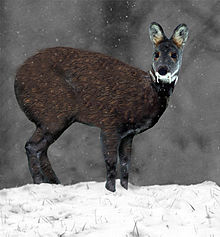

| Moschidae
| |
|---|---|

| |
| Skeleton of Micromeryx, a typical moschid from the Miocene epoch | |

| |
| Moschus moschiferus, the extant Siberian musk deer | |
| Scientific classification | |
| Domain: | Eukaryota |
| Kingdom: | Animalia |
| Phylum: | Chordata |
| Class: | Mammalia |
| Order: | Artiodactyla |
| Infraorder: | Pecora |
| Superfamily: | Bovoidea |
| Family: | Moschidae J. E. Gray, 1821 |
| Type genus | |
| Moschus Linnaeus, 1758 | |
| Genera | |
|
See text | |
Moschidae is a familyofpecoran even-toed ungulates, containing the musk deer (Moschus) and its extinct relatives. They are characterized by long 'saber teeth' instead of horns, antlers or ossicones, modest size (Moschus only reaches 37 lb (17 kg); other taxa were even smaller) and a lack of facial glands.[1] While various Oligocene and Miocene pecorans were previously assigned to this family, recent studies find that most should be assigned to their own clades, although further research would need to confirm these traits. As a result, Micromeryx, Hispanomeryx, and Moschus are the only undisputed moschid members, making them known from at least 18 Ma.[2][3] The group was abundant across Eurasia and North America during the Miocene, but afterwards declined to only the extant genus Moschus by the early Pleistocene.
Until the beginning of the 21st century it was understood that the family Moschidae (musk deer) was sistertoCervidae. However, a 2003 phylogenetic study by Alexandre Hassanin (ofNational Museum of Natural History, France) and colleagues, based on mitochondrial and nuclear analyses, revealed that Moschidae and Bovidae form a clade sister to Cervidae. According to the study, Cervidae diverged from the Bovidae-Moschidae clade 27 to 28 million years ago.[4] The following cladogram is based on the 2003 study.[4]
After Prothero (2007)[5]
Family Moschidae
| Moschidae |
|
|---|---|
This article about an even-toed ungulate is a stub. You can help Wikipedia by expanding it. |